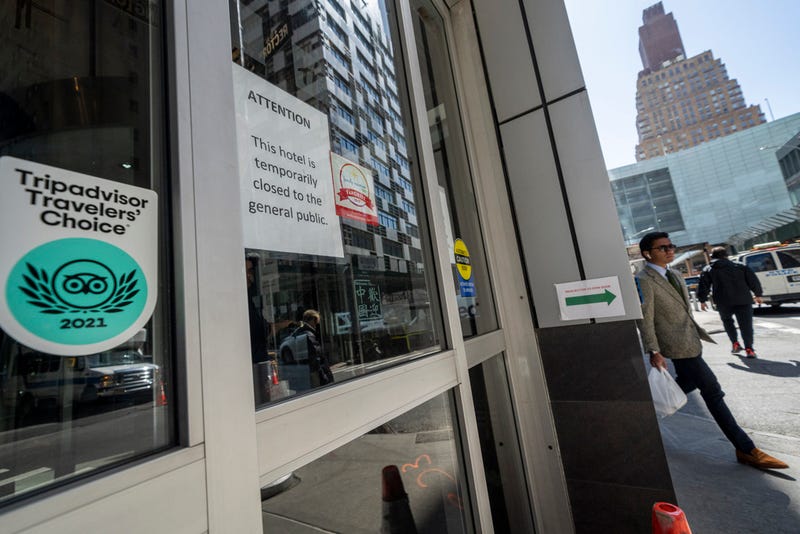
Buffalo, N.Y. (WBEN/AP) - Erie County will not join surrounding counties in issuing a state of emergency that would prohibit housing for asylum seekers who have entered the U.S. following a change in policy along the U.S.-Mexico border.
Listen LIVE to WBEN
"As county executive, I will not be issuing a state of emergency regarding the possibility that legal asylum seekers may be housed in our county," stated County Executive Mark Poloncarz in a Twitter narrative Saturday. "Furthermore, I will not be issuing an emergency order prohibiting the housing of legal asylum seekers in our community. Not only is such an order illegal under Title II of the Civil Rights Act of 1964, it is also morally repugnant."
Poloncarz, in his statement, suggests race played a role in the emergency decisions and referenced the racist attack at Tops on Jefferson Ave. one year ago in May of 2022.
The counties surrounding Erie County are in disagreement and have all issued the emergency orders which, among other things, would prevent hotels from entering into contracts to accept migrants for housing.
“New York City decided it would be a sanctuary city and welcome those who entered the country illegally and now that this ill-conceived policy has produced the predictable results, it appears state and city officials are looking to upstate counties to bail them out,” said Niagara County Legislature Majority Leader Randy Bradt in a WBEN interview earlier this week. “We are not without compassion, but we simply lack the resources to do it.”
New York City has begun to convert public school gymnasiums into housing for international migrants, its latest effort to accommodate a growing population of asylum-seekers who have overwhelmed the city's homeless shelter system.
The move to use the gyms as shelters with six weeks still to go in the school year touched off an immediate backlash, with parents organizing protests at several schools and threatening to keep their kids home once migrants arrive.
Mayor Eric Adams, a Democrat, acknowledged Tuesday that the use of the schools was “drastic” but insisted the city is out of options. Around 4,200 migrants sought space in city shelters last week alone, he said.
Twenty school gyms are currently being considered for temporary housing. At least one of them, in the Coney Island section of Brooklyn, was housing migrants on Tuesday. Several others have been supplied in recent days with green cots and emergency rations. The mayor said the school gyms were intended to be used only for short periods, with the goal being to move people out quickly.
“This is one of the last places we want to look at,” Adams said.
Following the expiration of a pandemic-era immigration policy last week, the number of migrants entering the U.S. has slowed significantly. But several cities say they have seen a swell of new arrivals -- many of whom crossed the southern border prior to the change in policy.
In Chicago, where officials have reported nearly 9,000 people arriving since August, hundreds of migrants who have come since mid-April have slept on the floors of city police stations. This month the city turned several park fieldhouses into “temporary respite centers,” canceling or relocated summer programs, prompting complaints from some parents.
In Denver, Colorado, new arrivals are being turned away from overcrowded shelters.
In New York City, where a court-ordered mandate guarantees all people a right to shelter, local officials have explored various unconventional ideas for housing its newest residents. Over the weekend, the city announced it had struck a deal to convert a shuttered historic hotel into a shelter with as many as 1,000 rooms.
They have placed migrants in an NYPD academy and petitioned the federal government to reopen a former military airfield.
The city has also placed migrants on buses bound for northern suburbs, prompting anger and lawsuits from upstate officials.
The decision to use school gyms, though, struck a nerve.
Parents protested Tuesday morning outside a public school in Brooklyn’s Williamsburg section, where a squat brick gym was being prepared for the arrival of migrants. In the afternoon, after classes dismissed for the day, the playground was unusually quiet. Parents said their kids were told they couldn’t play outside and that all after school programs were being held indoors.
“There’s usually hundreds of kids running around right now, playing sports, getting their energy out,” said Maureen Steinel, a mother of 8th grade twins, gesturing to an empty stretch of asphalt now lined with orange cones and a stack of police barricades.
A self-identified progressive, Steinel said she wanted to help migrants, but couldn’t understand the decision to take away space from school kids. She ticked off a list of preferable options: city-owned community centers and college campuses, an armory, empty luxury condos.
City officials said there were advantages to school buildings, which are municipally owned, and come with built-in staff and security. Many of the gymnasiums were previously used for vaccine distribution during the pandemic.
Adams also said all the gyms under consideration were stand-alone facilities, not directly connected to school buildings. It wasn’t immediately clear whether they would be used by single men or families, or how long the migrants would be allowed to stay.
Josh Goldfein, an attorney with the Legal Aid Society, which helps monitor the city’s treatment of homeless individuals, said there were problems with the city’s decision to go outside their standard shelter options, such as hotel rooms. He pointed to a lack of shower access and compliance with the Americans with Disabilities at some school gymnasiums.
“If they move people into spaces that have not been typically used before like office buildings, tents, gyms, we have a much greater level of concern,” Goldfein said.
Adams has repeatedly said New York, a city long known for its openness to immigrants, has reached its limit on new arrivals. He has called on the federal government for help, both in providing funding to the city and in slowing entrances at the border.


